Abstract
The timing group delay parameter (TGD) or differential code bias parameter (DCB) is an important factor that affects the performance of GNSS basic services; therefore, TGD and DCB must be taken seriously. Moreover, the TGD parameter is modulated in the navigation message, taking into account the impact of TGD on the performance of the basic service. International GNSS Monitoring and Assessment System (iGMAS) provides the broadcast ephemeris with TGD parameter and the Chinese Academy of Science (CAS) provides DCB products. In this paper, the current available BDS-3 TGD and DCB parameters are firstly described in detail, and the relationship of TGD and DCB for BDS-3 is figured out. Then, correction models of BDS-3 TGD and DCB in standard point positioning (SPP) or precise point positioning (PPP) are given, which can be applied in various situations. For the effects of TGD and DCB in the SPP and PPP solution processes, all the signals from BDS-3 were researched, and the validity of TGD and DCB has been further verified. The experimental results show that the accuracy of B1I, B1C and B2a single-frequency SPP with TGD or DCB correction was improved by approximately 12–60%. TGD will not be considered for B3I single-frequency, because the broadcast satellite clock offset is based on the B3I as the reference signal. The positioning accuracy of B1I/B3I and B1C/B2a dual-frequency SPP showed that the improvement range for horizontal components is 60.2% to 74.4%, and the vertical components improved by about 50% after the modification of TGD and DCB. In addition, most of the uncorrected code biases are mostly absorbed into the receiver clock bias and other parameters for PPP, resulting in longer convergence time. The convergence time can be max increased by up to 50% when the DCB parameters are corrected. Consequently, the positioning accuracy can reach the centimeter level after convergence, but it is critical for PPP convergence time and receiver clock bias that the TGD and DCB correction be considered seriously.
1. Introduction
The current BDS-3 offers all-weather, all-time, high-accuracy positioning and navigation and timing (PNT) services to users worldwide. A hybrid constellation consisting of satellites in three types of orbits was adopted by BDS-3, multi-frequency navigation signals were provided by BDS-3, so that the accuracy of services can be improved by the combination of multi-frequency signals [1,2,3]. There are five frequencies capable of transmitting in BDS-3 satellites, which include B1C, B2a, B2b, B1I and B3I [4].
It is well known that GNSS signals will be affected by hardware equipment during the propagation of satellites and receivers, resulting in time delays, which we call hardware delays [5,6]. In addition, different types of observation signals for different frequencies or the same frequency can cause different hardware delays due to differences in propagation links. Therefore, time group delay (TGD) or differential code bias (DCB) is often used to represent hardware delay differences for different signals [7]. The effect of TGD and DCB on pseudorange can reach the meter level, which was an important factor affecting the accuracy of navigation, positioning and timing [8]. As the user’s requirements for navigation and positioning increase, TGD or DCB must be corrected in navigation and positioning solutions [9]. Thence, TGD and DCB must be taken seriously. The BDS-3 satellite clock is referenced to the B3I and B1I/B3I ionosphere-free combination in broadcast ephemerides and precise products, respectively [10,11,12]. The TGD and DCB need to be corrected when using another single-frequency or dual-frequency ionosphere-free combination [8,13].
Originally, the control segment provided TGD parameter based on the values measured by the spacecraft contractor. Nevertheless, calibration was performed before the satellite launch, other factors such as the environment in space can cause certain variation [14,15]. Therefore, Liu et al. [16] presented the expression of TGD estimation error for phase center separation, and the effect on the user ranging measurement accuracy was also analyzed. With continuous monitoring of the BDS-2 system, the BDS-2 TGD parameters were updated on 21 July 2017; the reason was there is a systematic bias between the pseudoranges obtained by the BDS receivers of different correlated algorithms [17]. Thence, Zhang et al. [18] presented calibration of BDS TGD, and investigated the impact on the signal in space range error (SISRE) and the accuracy for single point positioning (SPP). The results showed that each satellite should correct the TGD. However, with the continuous development of precise products, the Chinese Academy of Sciences (CAS) have been providing DCB products of GNSS since 2014. Therefore, Li et al. [19] assessed the performance of BDS-3e DCB based on iGMAS and MEGX network observations. Furthermore, Wang et al. [20] compared the accuracy of broadcast TGD and DCB products for GPS, Galileo and BDS. The research showed that when comparing BDS-3 DCB and there was 3.8 ns deviation. For users, it is more important to correct TGD and DCB. Thence, Guo et al. [21] studied the correction models of TGD and DCB for BDS-2. In addition, Ge et al. [22] were given models of multi-GNSS, and analyzed the effect of code biases on SPP and PPP. Nevertheless, the TGD and DCB correction models of BDS-2 are given in previous researches, but such correction models of BDS-3 have not been researched and summarized. In addition, because of the lack of comprehensive research in the available literature, it is unclear the effectiveness of TGD and DCB and their impact on positioning.
In this contribution, we first analyzed the current BDS-3 DCB and TGD parameters, and demonstrated the relation between TGD and DCB parameters with practice with theory. Moreover, correction models of TGD and DCB parameters in SPP and PPP were derived in detail. Finally, we compared and analyzed the effects of TGD and DCB on BDS-3 SPP and PPP accuracy.
2. Theory of BDS-3 TGD/DCB Correction Models
2.1. Current Status of BDS-3 TGD and DCB
In order to maintain signal consistency, B1I Open Service Interface Control Document (ICD) [10] defined a “equipment group delay” for users using single-frequency B1I, B1C open Service ICD [12] defined for users using the pilot component of B1C single-frequency, B2a open Service ICD [11] defined for users using the B2a pilot component single-frequency.
BDS-3 as a developing constellation, CAS has started to provide BDS-3 official DCB products for users at present. Note that the pseudorange observation of the B1I and B3I signals are represented by C2I and C6I, respectively; C1X and C1P are represented in the pseudorange observation of B1C signal, and C5X and C5P are represented in the pseudorange observation of the B2a signal. Estimates of DCB have been averaged over a period of several days and change relatively little over a few weeks. We have given the time series of 30-day DCB estimated values for 25 Beidou-3 satellites. In order to express it more clearly, we have given the logarithmic form of DCB estimated values as showed in Figure 1 and Figure 2. As shown in the figures, the time series of the DCB values fluctuated smoothly. The DCB parameters run smoothly over one-month, which means that the DCB of the BDS-3 satellite can be stable enough to make long-term predictions.

Figure 1.
Time series of daily
().

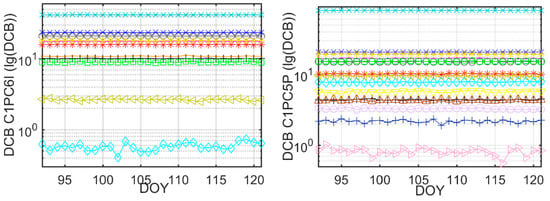
Figure 2.
Time series of daily DCBs ().
2.2. General Observation Model
The pseudorange P single-frequency observations equations of BDS-3 B1I, B3I, B1C and B2a can generally be written as follows:
where the subscripts r denotes the receiver; the superscript S denotes the BDS-3 satellite; and stands for the clock offset of satellite and receiver, respectively; stands for the geometric distance, c is the speed of light. represents slant troposphere delay; and represent the frequency-dependent multiplier factors (,); and indicate the ionospheric delay on the frequency and , respectively. For users, the code bias of the receiver will not be degrading accuracy of positioning. Therefore, the (j = B1I, B3I, B1C, B2a) represents the code bias only for the satellite part in this contribution. , , and are the code biases on B1I, B3I, B1C and B2a frequency, respectively.
The dual-frequency observation equation of pseudorange P for BDS-3 B1I, B3I, B1C and B2a will be described below:
where (i, j = B1I, B3I, B1C, B2a) represents the ionosphere-free pseudorange observable. (i, j = B1I, B3I, B1C, B2a) denotes the code bias after ionosphere-free linear combination (LC).
2.3. Correction Model with Broadcast Satellite Clocks
In order to further study the relationship between TGD and DCB, Figure 3 gives comparison results of the TGD and DCB from April 2020 where the broadcast ephemeris are provided by iGMAS and the DCB parameters by CAS. We need to pay attention to the B3I signal, which is the reference signal of the satellite clock offset for BDS-3 broadcast ephemeris. The difference between TGD and DCB for each satellite is also plotted in red or blue bars for 27 satellites. and can be expressed as:
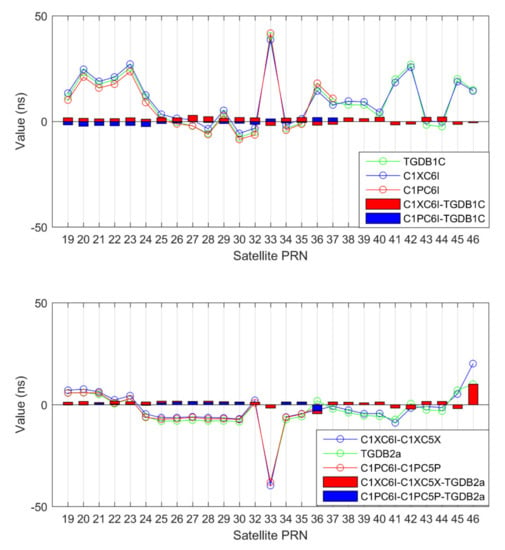
Figure 3.
Comparison of BDS-3 broadcast TGD with DCB.
As showed in Figure 3, the broadcast TGD parameter was consistent with the DCB parameter from CAS. Moreover, the root mean square (RMS) of the TGD and DCB difference is better than 2 ns. Thus, and can be interpreted as B1C-B3I and B2a-B3I differential code bias, respectively.
For single-frequency users, can then be written as:
For dual-frequency users, can be then written as:
2.4. Correction Model with Precise Satellite Clocks
At present, the BDS-3 precise satellite orbit and clock products of Wuhan University (WUM), as well as the BDS-3 DCB products of CAS is all derived from the B1I/B3I ionospheric-free LC. Therefore, when single-frequency users used the precise ephemeris, can be described below:
For dual-frequency users, when users used the precise ephemeris, can be then expressed below:
3. Materials and Methods
Six stations provided by iGMAS were selected for this experiment, including BJF1, BRCH, GUA1, WUH1, HMNS and KUN1. The data covered the 30-day period of day of year (DOY) 92 to 121, 2020. The broadcast ephemeris of BDS-3 was provided by iGMAS, WUM provides the BDS-3 precise satellite clock and orbit products and DCB products of BDS-3 provided by CAS. Moreover, Table 1 introduces the BDS-3 single-frequency and dual-frequency SPP and PPP data processing strategies in detail.

Table 1.
The summary of BDS-3 SPP and PPP processing strategies.
To test the influence of the code bias on positioning performance of BDS-3 with a different frequency combination, Table 2 gave the different schemes. Not only a single-frequency based on BDS-3 B1I, B3I, B1C and B2a signals, but also dual-frequency based on recommended B1I/B3I and B1C/B2a dual-frequency, are used for SPP testing. However, only B1I/B3I and B1C/B2a combinations are processed for PPP. Table 3 displays the information about six selected stations, including the type of receiver and antenna. Furthermore, the distribution of the stations as described in Figure 4, which can track BDS-3. Note that the station coordinates given in the SINEX file of iGMAS are sufficient to be used as the reference values for validation [26,27,28].

Table 2.
Summary of the processing strategies.

Table 3.
Summaries the basic information of iGMAS stations.
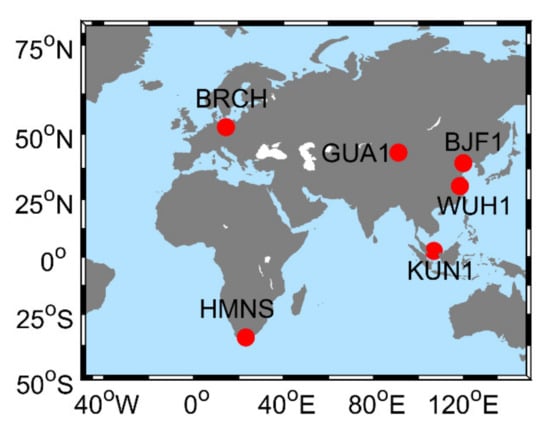
Figure 4.
The distribution of six selected iGMAS station.
4. Result and Discussion
4.1. Performance of SPP
4.1.1. Single-Frequency
In Figure 5, Figure 6, Figure 7, Figure 8, Figure 9, Figure 10 and Figure 11, the positioning errors of B1I, B3I, B1C and B2a single-frequency SPP in the east (E), north (N) and up (U) components of the six stations on 1 April 2020 are respectively given. We chose 1 April 2020 for one particular day, and the results show similar features on other days. It should be illustrated that the data are discontinuous because the residuals with absolute values greater than 30 m are detected and the observations will be deleted. Simultaneously combined with the below figures, three important conclusions can be drawn here. Firstly, combined with Figure 5, Figure 6, Figure 7, Figure 8, Figure 9 and Figure 10, it can be seen that after the modification of TGD and DCB parameters, the positioning accuracy of single-frequency (B1I, B1C and B2a) SPP has been significantly improved. For SPP based on the B3I signal, positioning results based on the B3I signal are not affected by TGD parameters. In addition, the positioning error of B3I is shown in Figure 11. Second, with the TGD or DCB parameters corrected, the performance of SPP for single-frequency BDS-3 can achieve the positioning accuracy of the metre-level. Third, we can explicitly see that the positioning results of the “tgd-corr” and “dcb-corr” schemes are significantly improved compared to the “non-corr” schemes. After correcting the TGD or DCB parameters, the positioning error ranges from −5 to 5 m, while positioning error of uncorrected TGD or DCB is more discrete and larger.
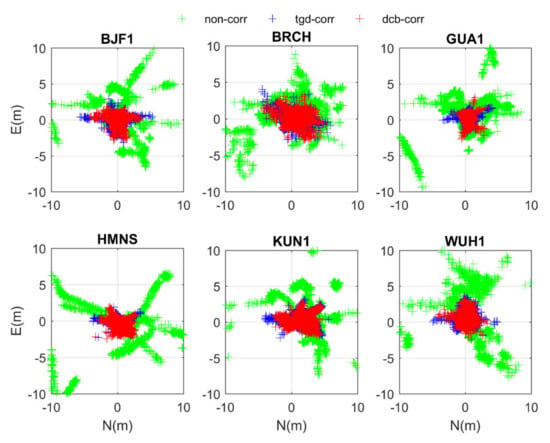
Figure 5.
Horizontal positioning error scatters with and without TGD or DCB correction of B1I SPP at six stations.
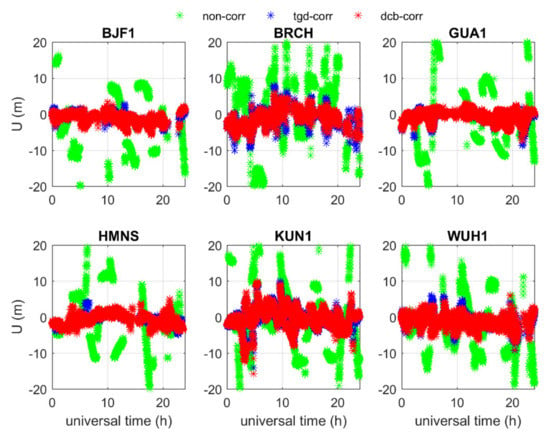
Figure 6.
Vertical positioning error scatters with and without TGD or DCB correction of B1I SPP at six stations.

Figure 7.
Horizontal positioning error scatters with and without TGD or DCB correction of B1C SPP at six stations.
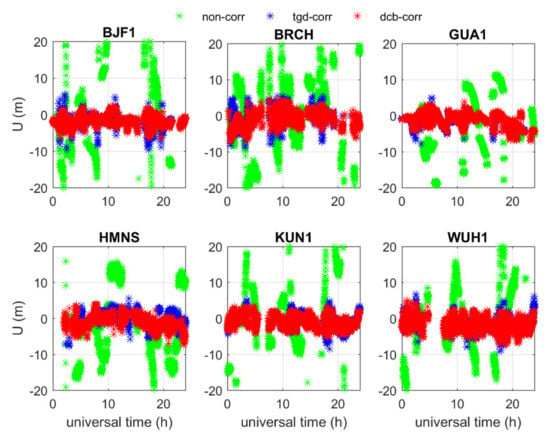
Figure 8.
Vertical positioning error scatters with and without TGD or DCB correction of B1C SPP at six stations.
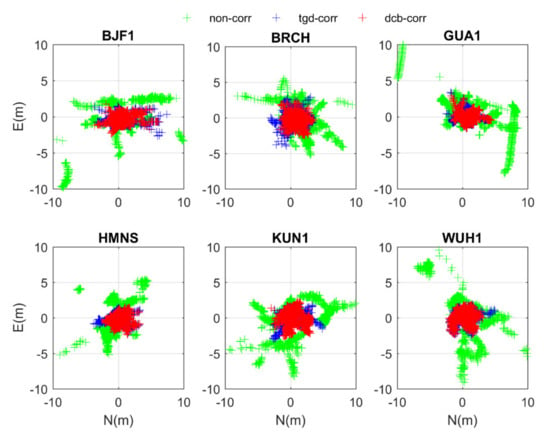
Figure 9.
Horizontal positioning error scatters with and without TGD or DCB correction of B2a SPP at six stations.
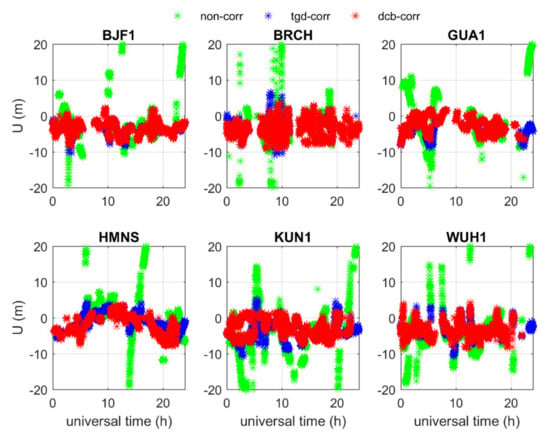
Figure 10.
Vertical positioning error scatters with and without TGD or DCB correction of B2a SPP at six stations.
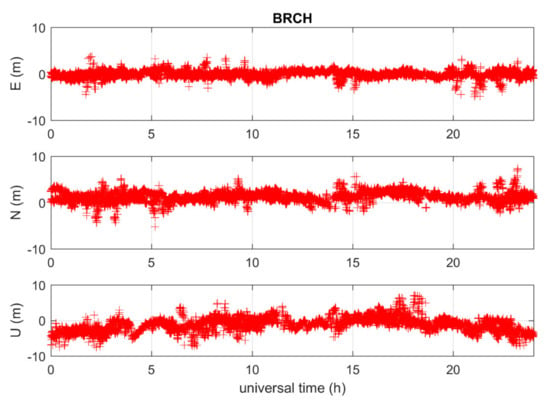
Figure 11.
Positioning error scatters of B3I SPP without DCB or TGD correction at BRCH station.
Figure 12 describes boxplot for the three-dimensional (3D) positioning errors with different schemes of six selected stations within 30 days. In Figure 12, it is intuitive to indicate that the outliers for the 3D positioning errors of single-frequency at each station are very small. Due to the BDS-3 pseudorange influenced by TGD or DCB parameters, thence, “tgd-corr “ or “dcb-corr” scheme showed better positioning accuracy, compared with the scheme of “non-corr”. We further compare the positioning error distribution based on “tgd-corr” and “dcb-corr” schemes, and we can conclude that with median and 75 percentile values being below 10 m, as shown in Figure 12. In addition, median and 75th percentile positioning errors with the TGD or DCB uncorrected are much larger than the results for other schemes, indicating that the correction of TGD or DCB parameters need to be considered during the BDS-3 solution process. Besides, the positioning error distribution of all stations is basically similar, which will not be repeated here.
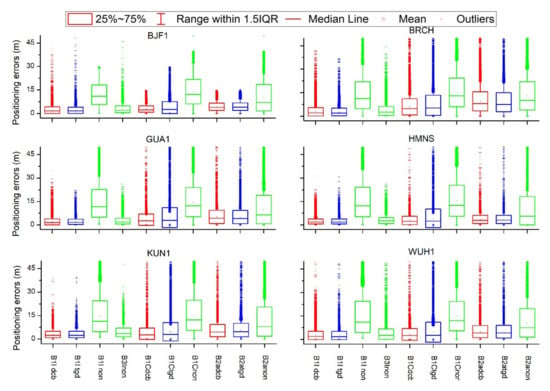
Figure 12.
Boxplot of the 3D positioning errors for single-frequency SPP distributions in the non-corr (green), dcb-corr (red) and tgd-corr (blue) and schemes for the period of April 2020.
For further research of the accuracy of positioning, we summarized the RMS and mean of the six stations for 30 days in Table 4. Analysis of the obtained results can be summarized in that the positioning accuracy of BDS-3 single-frequency SPP can achieve meter-level worldwide. From Table 4, we can conclude that the RMS of the horizontal component can be up to 2~4 m, and the RMS of the vertical component is about 6 m, when the TGD or DCB is uncorrected. In the “tgd-corr” and “dcb-corr” schemes, a significant improvement can be considered in positioning accuracy, because the code bias is corrected by TGD or DCB parameters. From Table 4 we can derive that the positioning accuracy can reach 2 to 4 m in the vertical component and 1 to 2 m in the horizontal component based on the TGD and DCB parameters correction schemes. However, B3I signal is relatively special, and we have mentioned before that the positioning results were not affected by the code bias because the satellite clock of broadcast ephemeris was referred to the B3I signal.

Table 4.
RMS in BDS-3 single-frequency SPP performance with different schemes (m).
To further verify our conclusions, Figure 13 describes the pseudorange residuals in different schemes at station BRCH; in addition, the different satellites in the figure are represented in different colors. As we can see from the figure, the pseudorange residual of each satellite calculated by the “non-corr” scheme has a significant systematic bias, and the offset range related to the satellite is several meters. On the contrary, it is noteworthy that the systematic bias from the results of the “tgd-corr” and “dcb-corr” schemes are significantly reduced. Furthermore, pseudorange residuals distribution based on the TGD and DCB parameters correction schemes look more reasonable and closer to zero-mean random noise. Therefore, these findings further confirm that the TGD and DCB parameters should be modified when the BDS-3 B1I, B1C and B2a signals are used for single-frequency positioning. Furthermore, daily variation in the number of BDS-3 satellites and the value of positioning dilution of precision (PDOP) on 1 April 2020 is also given, as shown in Figure 14. We found that the number of BDS-3 satellites has increased significantly worldwide at the present stage; therefore, the correction of TGD or DCB parameters is even more important for stations around the world.
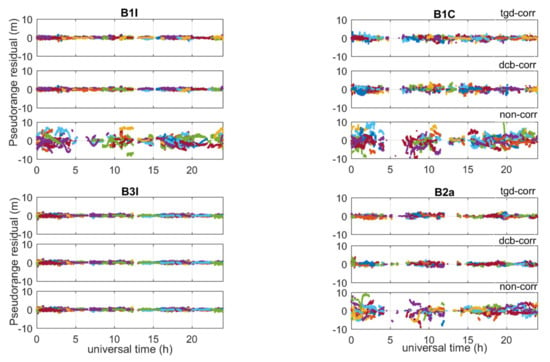
Figure 13.
Pseudorange residual scatters of B1I, B3I, B1C and B2a SPP with different schemes at BRCH station.

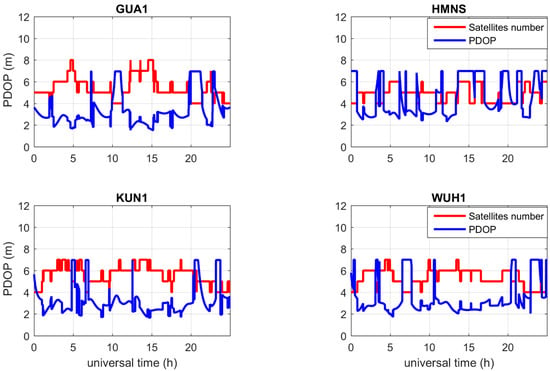
Figure 14.
The visible BDS-3 satellites number and PDOP of the six selected stations on DOY 92, 2020.
4.1.2. Dual-Frequency
Figure 15, Figure 16, Figure 17 and Figure 18 separately show the positioning errors scatters for B1I/B3I and B1C/B2a SPP on 1 April 2020. It is obvious that the performance of SPP for dual-frequency BDS-3 also can achieve the positioning accuracy of the metre-level. The positioning errors of the TGD and DCB correction schemes are less than 5 m; however, the positioning errors of “non-corr” scheme are within 10 m. Interestingly, comparing positioning errors of dual-frequency SPP with that of single-frequency in Figure 5, Figure 6, Figure 7, Figure 8, Figure 9, Figure 10 and Figure 11, we can draw that the positioning accuracy of SPP based on dual-frequency is slightly worse than that of single-frequency. In addition, in terms of noise impact, the noise of dual-frequency positioning error is significantly larger than single-frequency. Actually, this phenomenon is reasonable, when we realize that the observation noise of dual-frequency LC will increase significantly due to various interesting factors, and the noise amplification factor of B1I/B3I dual-frequency SPP scheme is 3.5 [20]. Moreover, the ionospheric delay correction model of BDS-3 adopts the BDGIM, and the BDS-3 satellites broadcast a set of ionospheric parameters per hour, which makes the accuracy of single-frequency ionospheric correction error better.
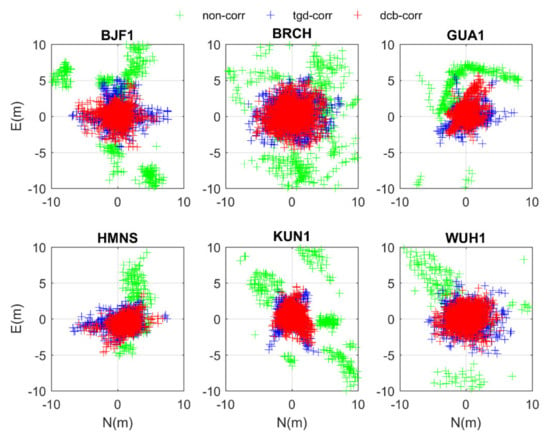
Figure 15.
Horizontal positioning error scatters with and without TGD or DCB correction of B1I/B3I SPP at six stations.
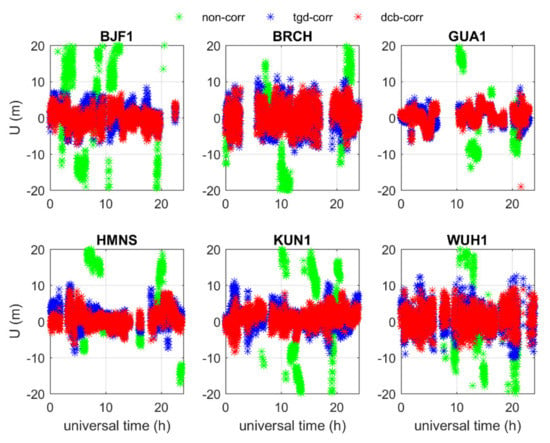
Figure 16.
Vertical positioning error scatters with and without TGD or DCB correction of B1I/B3I SPP at six stations.
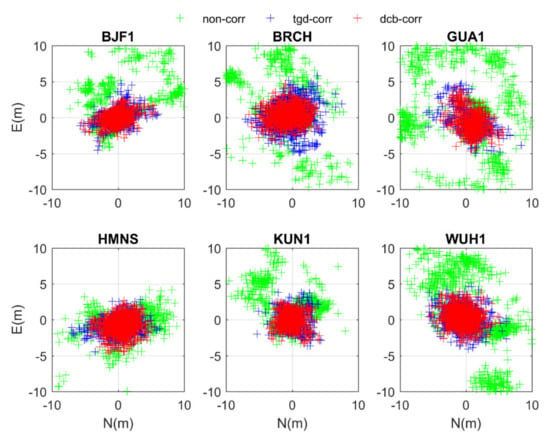
Figure 17.
Horizontal positioning error scatters with and without TGD or DCB correction of B1C/B2a SPP at six stations.
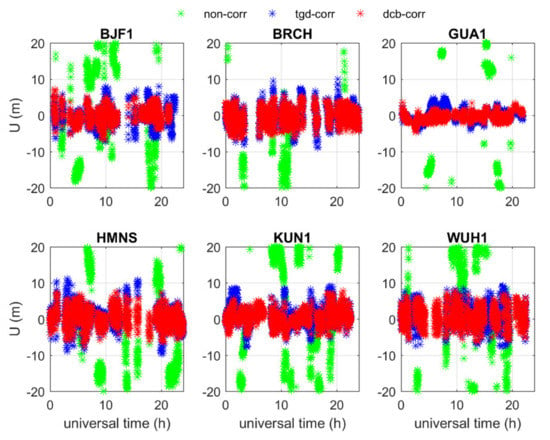
Figure 18.
Vertical positioning error scatters with and without TGD or DCB correction of B1C/B2a SPP at six stations.
In further verification and analysis, the boxplot of the positioning errors distribution are with “tgd-corr”, “dcb-corr” and “non-corr” schemes in April 2020, as given in Figure 19. As can be seen intuitively from the figure, there are very few outliers in different frequency combinations, which further prove the reliability of BDS-3 positioning. Furthermore, the positioning errors of dual-frequency (B1I/B3I, B1C/B2a) are basically consistent for the six selected stations. In addition, the medians and 75th percentiles for the TGD and DCB correction schemes of the selected stations are within 10 m. In contrast, the medians and 75th percentiles of the TGD and DCB unmodified scheme are much larger than the other two schemes, which further demonstrate the need to be corrected TGD and DCB parameters when positioning with BDS-3.
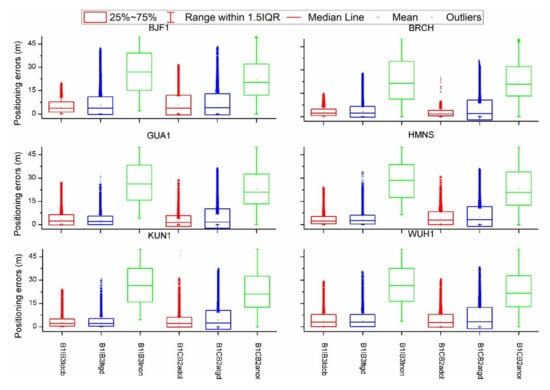
Figure 19.
Boxplot of 3D positioning errors for dual-frequency SPP distributions in the non-corr (green), tgd-corr (blue) and dcb-corr (red) schemes for the period of April 2020.
To further analyse the effect of the TGD or DCB on dual-frequency SPP, the RMS in BDS-3 dual-frequency SPP performance with different schemes is shown in Table 5. Moreover, Table 5 also shows the improvement of the three components in the “tgd-corr” and “dcb-corr” schemes compared with the uncorrected TGD and DCB scheme. Combined with Figure 15, Figure 16, Figure 17, Figure 18 and Figure 19 and Table 5, correction of TGD and DCB can significantly improve positioning accuracy. Besides, compared with the TGD and DCB unmodified scheme, the positioning errors distribution of the other two schemes is more reasonable. Compared with Table 4 and Table 5, it is also possible to obtain that single-frequency positioning accuracy is better than dual-frequency. We can explain it by the explanation mentioned before that the observation noise of dual-frequency LC is obviously greater. Nevertheless, the positioning accuracy of B1I/B3I and B1C/B2a SPP can reach 1 to 2 m horizontally and 3 to 4 m vertically. Consequently, this further supports the conclusions we reached before, which is the positioning of the BDS-3 needs to modify the TGD and DCB parameters, except for the B3I signal. To further support our conclusions, we have given the pseudorange residual for the BRCH station with different schemes in Figure 20. By comparing the pseudorange residuals of the different schemes in the graph, in the “non-corr” scheme, each satellite has a large systematic bias. However, the other two schemes have relatively small systematic bias. Therefore, this further validates that the TGD and DCB parameters of BDS-3 signals (except B3I signal) that need to be modified.

Table 5.
RMS in BDS-3 dual-frequency SPP performance with different schemes (m).

Figure 20.
Pseudorange residual scatters of B1I/B3I and B1C/B2a SPP with different schemes at BRCH station.
4.2. Performance of PPP
As we mentioned earlier, the BDS-3 precise satellite clock and orbit products of WUM and BDS-3 DCB products of CAS are taken the B1I/B3I ionospheric-free LC as a reference at present. Thence, the “non-corr” scheme was only implemented for B1I/B3I PPP, and Figure 21 illustrates the PPP solutions B1I/B3I PPP performance for the selected stations. Additionally, Figure 22 shows the positioning errors of B1C/B2a PPP with and without DCB correction with each color representing the E, N and U components, respectively. Moreover, the positioning accuracy of PPP was calculated and summarized in Table 6. Combining Figure 21, Figure 22 and Table 6, we can obtain that the B1I/B3I PPP exhibits positioning performance similar to B1C/B2a. For dual-frequency PPP, the positioning accuracy of the horizontal component is up to 2~3 cm, and that of the vertical component is up to 3~4 cm. Due to the increasing contribution of the high-precision carrier phase in the subsequent epochs, the positioning accuracy in the horizontal and vertical components is within 0.1 m in the last. However, we can clearly see that the DCB parameter has a greater effect on the convergence time on the three components. Figure 23 gives the average convergence time and the improvement of B1C/B2a PPP with different schemes. The convergence time for B1C/B2a based on the “dcb-corr” scheme is significantly shorter than the “non-corr” scheme. Furthermore, the convergence time can be max increased by up to 50% when the DCB parameters are corrected for the six stations.
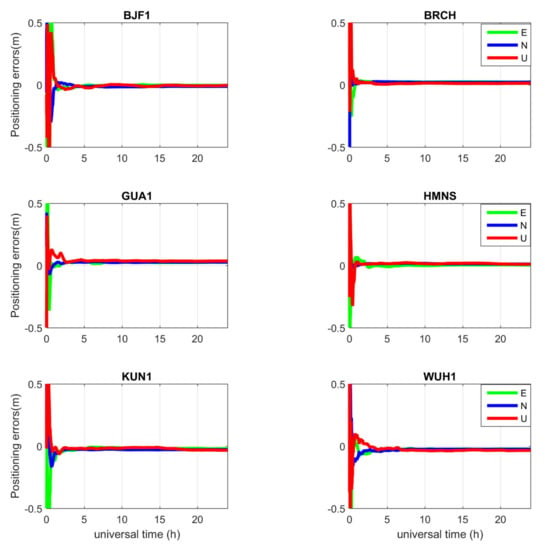
Figure 21.
Positioning errors of B1I/B3I PPP without DCB correction at six stations.


Figure 22.
Positioning error of B1C/B2a PPP with and without DCB correction at six stations (unit: m).

Table 6.
RMS of BDS-3 PPP with and without DCB correction (m).
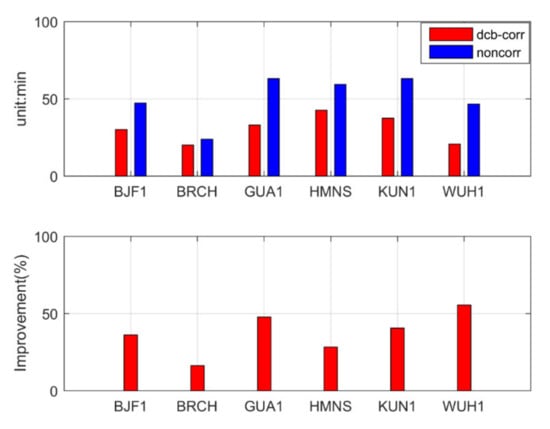
Figure 23.
Average convergence time and the improvement of B1C/B2a PPP with different schemes for six stations.
Although the effects of differential code biases can be mitigated as time goes by, and similar positioning accuracy can be obtained after convergence, the bias will be absorbed and affected by other parameters. Take BRCH station as an example; Figure 24 illustrates the pseudorange residuals of B1C/B2a PPP obtained with or without DCB correction. The residuals of the “non-corr” scheme in Figure 24 shows significant systematic bias and a satellite-related offset range of several metres. By contrast, the residuals of the other schemes look more reasonable and behave like zero-mean random noise. For further research of the effect of code biases to the additional parameters, Figure 25 shows the time series of B1C/B2a PPP receiver clock obtained with or without DCB correction for BRCH and HMNS stations. Most of the unmodified code biases were absorbed into the receiver clock and other parameters. The differences of receiver clock of the “non-corr” scheme range up to 10–20 ns, compared with the “dcb-corr” scheme. Thence, this should be considered with great caution for time and frequency transfer applications based on BDS-3 high performance.
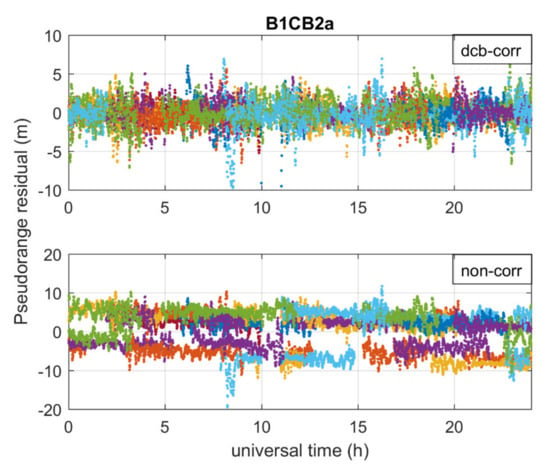
Figure 24.
Pseudorange residual scatters of PPP with different schemes at BRCH station.
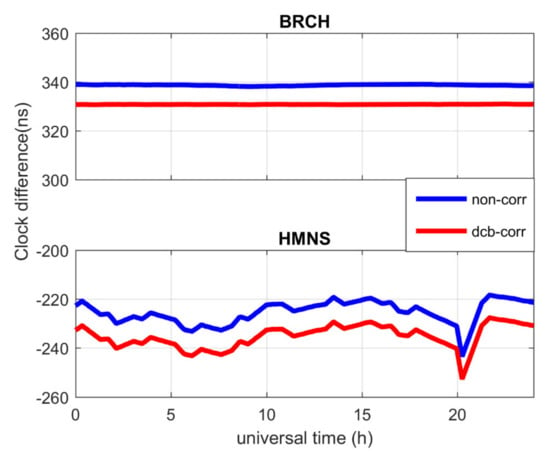
Figure 25.
Time series of BDS-3 PPP receiver clock obtained with different schemes at BRCH and HMNS stations.
5. Conclusions
In this present work, we first summarize currently available BDS-3 TGD and DCB parameters, and the relationship between TGD and DCB was revealed with numerical experiments. Comparisons showed that the value of broadcast TGD in the broadcast ephemerides agreed well with the CAS DCB. Then, correction models for various occasions of BDS-3 positioning were developed. The impact of TGD or DCB parameters on BDS-3 single-frequencies and dual-frequency combinations of SPP and PPP positioning were evaluated by three different scenarios schemes (“dcb-corr”, “tgd-corr” and “non-corr”). With analysis of the effects of TGD and DCB on BDS-3 positioning, we found that the uncorrected TGD or DCB parameters seriously affected the positioning accuracy of the SPP, whether using single- or dual-frequency combinations. The TGD broadcasted in the broadcast ephemeris and the DCB parameters provided by CAS are both beneficial to the performance of BDS-3 positioning. Although the effects of differential code biases can be mitigated as time goes by, and similar positioning accuracy can be obtained after convergence, the bias can be absorbed and affected by other parameters. Consequently, convergence time and receiver clock will be absorbed by the bias. Thence, for the high-performance positioning and timing users, the TGD and DCB correction models must be considered seriously.
Furthermore, for multi-GNSS and multi-frequency, observations from different constellations, signals, frequencies and channels need to be processed along with each other; therefore, it is very important to consider the differential code biases in a consistent modeling of all observations. We need to consider the impact of differential code bias particularly in the applications of multi-GNSS positioning, precise timing and tropospheric delay estimation. We will do research on this in the future.
Author Contributions
P.D., J.X., Y.G. and X.Y. conceived and designed the experiments; P.D. performed the data analysis and wrote the article; Y.G., J.X. and W.Q. validated the experimental results and reviewed the paper. Y.D. and Z.Z. supervised the experiments. All authors have read and agreed to the published version of the manuscript.
Funding
This research was funded by the Beidou New Time-space Intelligent Industry Development Collaborative Innovation Center (No. 0508-2).
Institutional Review Board Statement
Not Applicable.
Informed Consent Statement
Informed consent was obtained from all subjects involved in the study.
Data Availability Statement
No new data were created or analyzed in this study. Data sharing is not applicable to this article.
Acknowledgments
The contribution of data from iGMAS is gratefully acknowledged. The authors gratefully acknowledge Wuhan University for providing products, and the Chinese Academy of Sciences for providing DCB products.
Conflicts of Interest
The authors declare no conflict of interest.
References
- Zhang, R.; Tu, R.; Liu, J.; Hong, J.; Fan, L.; Zhang, P.; Lu, X. Impact of BDS-3 experimental satellites to BDS-2: Service area, precise products, precise positioning. Adv. Space Res. 2018, 62, 829–844. [Google Scholar] [CrossRef]
- Wu, Z.; Zhou, S.; Hu, X.; Liu, L.; Shuai, T.; Xie, Y.; Tang, C.; Pan, J.; Zhu, L.; Chang, Z. Performance of the BDS3 experimental satellite passive hydrogen maser. GPS Solut. 2018, 22, 43. [Google Scholar] [CrossRef]
- Yang, Y.; Gao, W.; Guo, S.; Mao, Y.; Yang, Y. Introduction to BeiDou-3 navigation satellite system. Navigation 2019, 66, 7–18. [Google Scholar] [CrossRef]
- Xie, X.; Fang, R.; Geng, T.; Wang, G.; Zhao, Q.; Liu, J. Characterization of GNSS Signals Tracked by the iGMAS Network Considering Recent BDS-3 Satellites. Remote Sens. 2018, 10, 1736. [Google Scholar] [CrossRef]
- CSNO. BeiDou Navigation Satellite System Open Service Performance Standard, Version 2.0; China Satellite Navigation Office: Beijing, China, 2018.
- Håkansson, M.; Jensen, A.B.O.; Horemuz, M.; Hedling, G. Review of code and phase biases in multi-GNSS positioning. GPS Solut. 2016, 21, 849–860. [Google Scholar] [CrossRef]
- Montenbruck, O.; Hauschild, A.; Steigenberger, P. Differential Code Bias Estimation using Multi-GNSS Observations and Global Ionosphere Maps. Navigation 2014, 61, 191–201. [Google Scholar] [CrossRef]
- Montenbruck, O.; Hauschild, A. Code Biases in Multi-GNSS Point Positioning. In Proceedings of the 2013 International Technical Meeting of The Institute of Navigation, San Diego, CA, USA, 27–29 January 2013; pp. 616–628. [Google Scholar]
- Teunissen, P.J.G.; Montebruck, O. Springer Handbook of Global Navigation Satellite Systems; Springer International Publishing: Cham, Switzerland, 2017; pp. 967–982. [Google Scholar]
- CSNO. BeiDou Navigation Satellite System Signal in Space Interface Control Document-Open Service Signal B1I, Version 1.0; China Satellite Navigation Office: Beijing, China, 2012.
- CSNO. BeiDou Navigation Satellite System Signal in Space Interface Control Document, Open Service Signal B2a (Version 1.0); China Satellite Navigation Office: Beijing, China, 2017.
- CSNO. BeiDou Navigation Satellite System Signal in Space Interface Control Document, Open Service Signal B1C (Version 1.0); China Satellite Navigation Office: Beijing, China, 2017.
- Montenbruck, O.; Steigenberger, P.; Hauschild, A. Broadcast versus precise ephemerides: A multi-GNSS perspective. GPS Solut. 2015, 19, 321–333. [Google Scholar] [CrossRef]
- Coco, D.; Coker, C.; Dahlke, S.; Clynch, J. Variability of GPS satellite differential group delay biases. IEEE Trans. Aerosp. Electron. Syst. 1991, 27, 931–938. [Google Scholar] [CrossRef]
- Sardón, E.; Zarraoa, N. Estimation of total electron content using GPS data: How stable are the differential satellite and receiver instrumental biases? Radio Sci. 1997, 32, 1899–1910. [Google Scholar] [CrossRef]
- Liu, J.; Bi, S.; Zheng, J.; Xie, J. Effect of Separation of Navigation Satellite Antenna Inter-Frequency Phase Centers on TGD Parameter. In China Satellite Navigation Conference (CSNC) 2014 Proceedings: Volume II; Sun, J., Jiao, W., Lu, M., Eds.; Lecture Notes in Electrical Engineering; Springer: Berlin/Heidelberg, Germany, 2014; pp. 227–238. [Google Scholar] [CrossRef]
- Zhang, Y.; Chen, J.; Gong, X.; Chen, Q. The update of BDS-2 TGD and its impact on positioning. Adv. Space Res. 2020, 65, 2645–2661. [Google Scholar] [CrossRef]
- Zhang, Y.; Wang, H.; Chen, J.; Wang, A.; Meng, L.; Wang, E. Calibration and Impact of BeiDou Satellite-Dependent Timing Group Delay Bias. Remote Sens. 2020, 12, 192. [Google Scholar] [CrossRef]
- Li, X.; Xie, W.; Huang, J.; Ma, T.; Zhang, X.; Yuan, Y. Estimation and analysis of differential code biases for BDS3/BDS2 using iGMAS and MGEX observations. J. Geod. 2019, 93, 419–435. [Google Scholar] [CrossRef]
- Guo, F.; Zhang, X.; Wang, J. Timing group delay and differential code bias corrections for BeiDou positioning. J. Geod. 2015, 89, 427–445. [Google Scholar] [CrossRef]
- Ge, Y.; Zhou, F.; Sun, B.; Wang, S.; Shi, B. The Impact of Satellite Time Group Delay and Inter-Frequency Differential Code Bias Corrections on Multi-GNSS Combined Positioning. Sensors 2017, 17, 602. [Google Scholar] [CrossRef] [PubMed]
- Wang, N.; Li, Z.; Montenbruck, O.; Tang, C. Quality assessment of GPS, Galileo and BeiDou-2/3 satellite broadcast group delays. Adv. Space Res. 2019, 64, 1764–1779. [Google Scholar] [CrossRef]
- Wu, J.T.; Wu, S.C.; Hajj, G.A.; Bertiger, W.I.; Lichten, S.M. Effects of antenna orienation on GPS carrier phase. Manuscr. Geod. 1992, 18, 91–98. [Google Scholar]
- Saastamoinen, J. Atmospheric Correction for the Troposphere and Stratosphere in Radio Ranging Satellites. Use Artif. Satell. Geod. 2013, 15, 247–251. [Google Scholar] [CrossRef]
- Petit, G.; Luzum, B. IERS Conventions; No. IERS-TN-36; Bureau International Des Poids Et Mesures Sevres: Serves, France, 2010. [Google Scholar]
- Jiao, G.; Song, S.; Ge, Y.; Su, K.; Liu, Y. Assessment of BeiDou-3 and Multi-GNSS Precise Point Positioning Performance. Sensors 2019, 19, 2496. [Google Scholar] [CrossRef] [PubMed]
- Ferland, R.; Piraszewski, M. The IGS-combined station coordinates, earth rotation parameters and apparent geocenter. J. Geod. 2009, 83, 385–392. [Google Scholar] [CrossRef]
- Cai, C.; Gao, Y.; Pan, L.; Zhu, J. Precise point positioning with quad-constellations: GPS, BeiDou, GLONASS and Galileo. Adv. Space Res. 2015, 56, 133–143. [Google Scholar] [CrossRef]
Publisher’s Note: MDPI stays neutral with regard to jurisdictional claims in published maps and institutional affiliations. |
© 2020 by the authors. Licensee MDPI, Basel, Switzerland. This article is an open access article distributed under the terms and conditions of the Creative Commons Attribution (CC BY) license (http://creativecommons.org/licenses/by/4.0/).